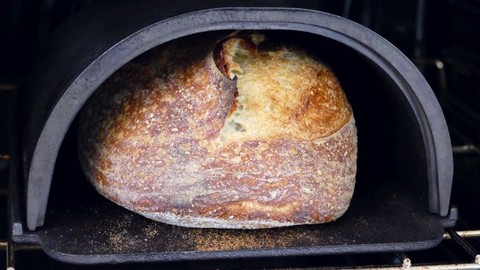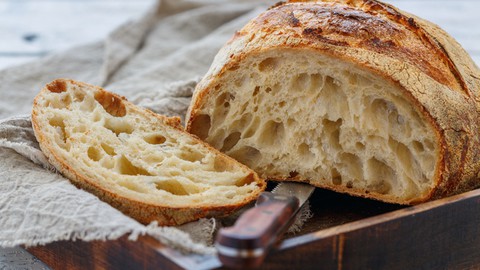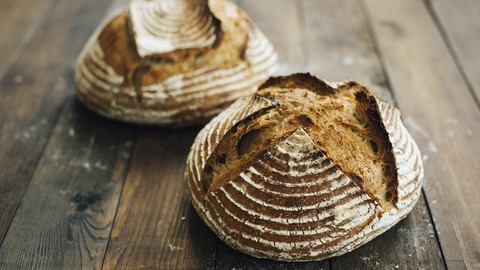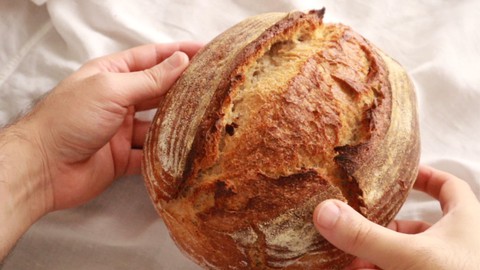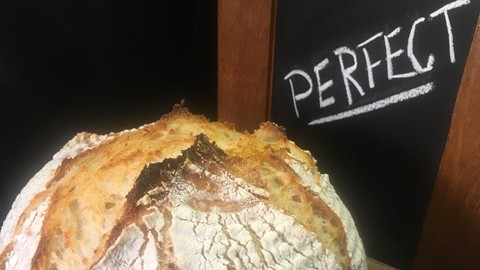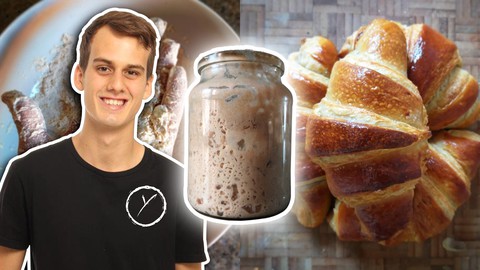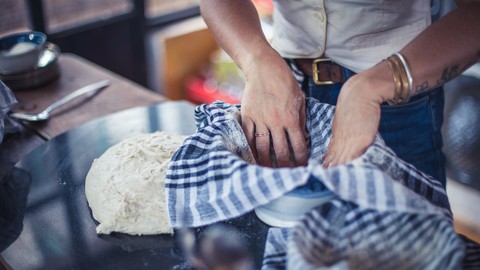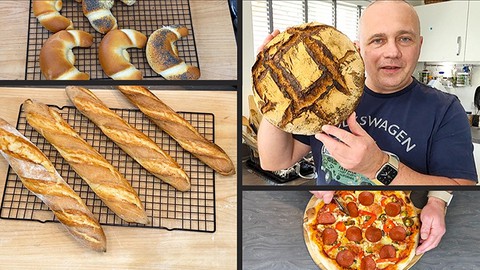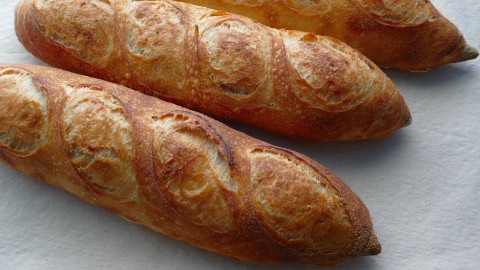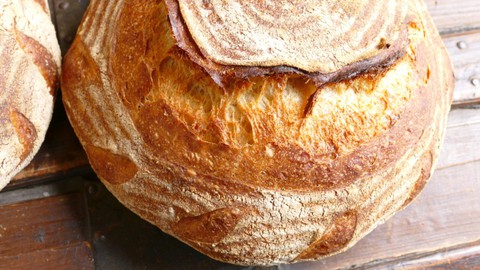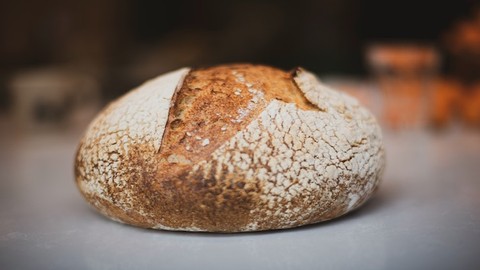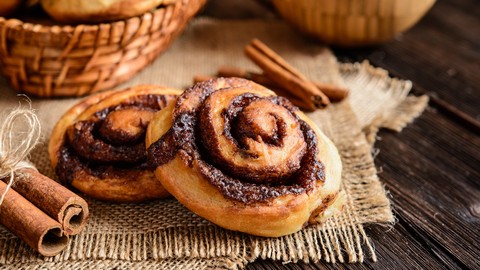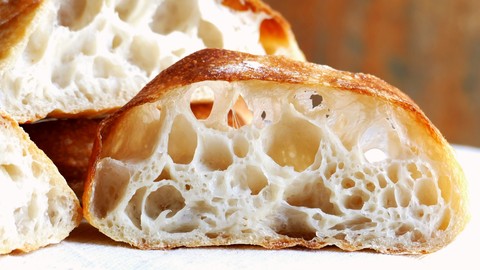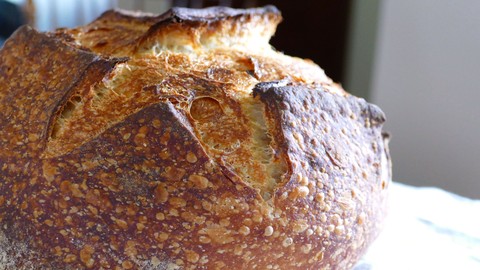What you'll learn
- 🎂 Discover innovative baking techniques, breaking away from conventional methods to expand your culinary skills.
- 🥖 Master the art of gluten washing, identify gluten and starch, and evaluate flour fitness for perfect bread-making!
- 📜 Gain access to exclusive printable recipes for Ciabatta, sourdough pancakes, and various hydration-level sourdough breads.
- 🌾 Elevate your knowledge of sourdough starter stages to improve your baking process.
- 🔧 Learn essential tips for correcting baking formula errors effectively.
- 🧪 Understand easy methods to test the strength of local flour for bread-making excellence.
Course Content
Welcome!
3 lecturesWelcome to Sourdough Bread Baking Exploration. We will be exploring different aspects of flour, protein, gluten, hydration and seeing the different stages of a sourdough starter. We will also be baking bread while we experiment. Let's have some fun!
You will need a sourdough starter to follow in this course. The video series in this lecture will help you get your own sourdough starter going and show you how to take care of it, how to make sourdough waffles and bread!
Get started by viewing the video series, "Make Your Own Sourdough Starter With Me!" and by downloading the free book.
Testing the Protein & Quality of Flour
9 lecturesLet's test the local flour you have available to you and see if it's able to bake up a loaf of bread. This is a quick easy test to help you determine the quality of a flour especially if you don't know how strong it is and whether it can be used to make bread with.
In this lecture we will begin our test of four different types of flour to determine their quality and whether we can use the flour to make bread with. We will bring the flour to 70% hydration and allow it to set for 30 minutes.
After 30 minutes we will do a windowpane test to see how the gluten bonding is coming along and determine after such a short time, how strong the gluten already is.
After 60 minutes we will test the strength of the gluten again and talk about ways to protect the gluten in weak dough.
Let's take a minute to talk about hydration in dough and also share a few tips.
After the flour test we will be mixing the doughs together and making a loaf of sourdough bread from it. This lecture is the formula for the bread (or the instructions to turn our test into a loaf!) Everyone's bread will come out different depending upon what type of flour they tested. Look forward to having a lot of fun with this experiment.
Let's have fun with the test dough and make a loaf of sourdough bread out of it!
We will fold the dough a few times during bulk ferment and then shape our loaf and refrigerate it when it's done fermenting.
Refrigerate the dough overnight and then bake it the next morning.
Gluten Washing - Discover Gluten
5 lecturesFollow the formula to make the dough at 66% hydration and then do the gluten washing.
Mix four different types of dough for the Gluten Washing experiment.
To develop the gluten before we wash it, fold the dough at least once.
Let's wash the dough and uncover the gluten. This is the fun part!
Examine the gluten and see how it looks and how it acts. You can also see the starch that was washed out.
Recover from a Mistake - Ciabatta Bread
6 lecturesWhile trying to make test boules to compare All Purpose flour vs Bread Flour, I made a mistake with my hydration calculator. I ended up with 92% hydration dough. Follow as I fix my mistake by making Ciabatta bread.
This 92% hydration Ciabatta bread was made as the result of a mistake. It is terrific! Here is the formula and downloadable printout formula.
Fold the dough and develop the gluten structure.
The dough is now ready to final proof and shape. It's the other way around for this Ciabatta bread!
Shape your Ciabatta loaves and get them into the oven to bake.
Bake the rest of the Ciabatta loaves and once they are cool, slice into them! Big holes make great craters for butter!
All Purpose Flour vs Bread Flour - At Different Hydrations
16 lecturesWhat do you think will happen during the experiment? How will a lower protein flour compare to a higher protein flour? The results might surprise you.
After making a mistake the first time I did this experiment and made Ciabatta instead, I redid the experiment here to compare All Purpose flour with Bread flour.
Start by making the first loaf with all purpose flour. This dough is at 68% hydration and the protein content is at 10%
Now we'll make the next two loaves following the exact same formula as the all purpose loaf. These loaves will be a blend of all purpose and bread flour and also just bread flour.
Let's warm up the dough and finish the bulk ferment. We'll follow what each dough looks like and how it acts.
After refrigeration, take out the dough and let it warm up and bulk ferment.
See what dough looks like when it's done bulk fermenting.
We'll shape our batards and proof them.
Score and then bake the loaves and see how they turn out.
It's time to compare the finished loaves, what are the differences?
Now let's do the loaves again and use a higher hydration to see what happens. Can you make a loaf using all purpose flour and a higher hydration?
See how the flours perform with a higher hydration dough at 78%
In this formula I used a higher quality bread flour called Morbread flour and took it to an even higher hydration level of 88% I also used a double hydration method and an autolyse to help the gluten bond better before adding the additional water, starter and salt.
Let's go even higher in hydration. This time I'm using a great quality flour an autolyse and double hydration. We'll take the hydration to 88% this time.
Let's bake up our high hydration loaf and slice into it.
Now that the experiment is over what do you think? See some suggestions for using low or high protein flours.
The Life Cycle of a Sourdough Starter
6 lecturesThe first stage of a sourdough starter life cycle is when you feed it.
I mentioned that I made pancakes from the discard when I was filming stage one. Here is the pancake formula I used to make the pancakes. The formula is simple and easy to throw together and tastes delicious.
The second stage of a sourdough starter is before peak and after feeding.
The third stage of a sourdough starter is peak.
See what the peak stage looks like and what happens after.
The fifth stage of a sourdough starter is it's decline and demise.
Conclusion
2 lecturesThank you for joining me in exploring sourdough! I had a lot of fun and I hope you did too!
Description
Course Last Updated: 5/10/2021
Welcome to an exciting journey into the world of sourdough baking! 🍞 Discover the fun behind the "why" of baking, inspired by countless questions I received. This course is perfect for those who have completed the Sourdough Bread Baking 101 and caters to both beginning and intermediate bakers.
No sourdough starter? No problem! I'll guide you step-by-step with helpful videos to create your starter from scratch. Plus, you'll receive a free downloadable e-book to print and keep handy.
Here's what you will learn:
-
🔍 Protein Quality in Flour: Test and bake with different flours, uncovering how each flour affects your loaf 🥖.
-
🌾 Gluten Washing: Discover how to extract and analyze gluten and starch from flour.
-
❗ Recovering from Mistakes: Learn valuable lessons from mishaps and create beautiful Ciabatta bread.
-
⚖️ All Purpose Flour VS Bread Flour: Conduct three experiments to compare differences, pushing to higher hydration levels with surprising outcomes.
-
💧Double Hydration Technique: Use high-quality bread flour to bake an impressive 88% hydration loaf.
-
🌀 Sourdough Starter Life Cycle: Understand its journey from vitality to exhaustion, and transform discards into delightful pancakes.
Additionally, we’ll delve into freezing dough and its effects, how to safeguard gluten in weak doughs, and methods to slow down fermentation. Make sure to check the links in the bonus section.
Let's embark on this delightful sourdough adventure together! 🥯 Join me, and let's bake with passion and precision.
Best,
Teresa
Who this course is for:
- Beginners and Intermediate students eager to enhance their baking skills.
- Anyone curious to explore the fascinating techniques and methods of sourdough bread baking.
Course Reviews
-
😀 Virginia Schubert
-
😀 Rebecca Monk
-
😀 Natalia Poplyonkina
-
😀 Juan Ruiz
-
😀 Alejandro Herrero Bueno
-
😀 Denine thrasher
-
😀 Stephanie Hendrixson
-
😀 Tracy Bowman
-
😀 Wiebke Papenfus
Teresa explains everything so well! I love her courses
-
😀 Maisy Cheung
-
😀 Lilit Babalikhyan
-
😀 Susan McDonough
-
😀 Monica Mork Butcher
-
😀 Michael Knotts
-
😐 Charles Frumer
-
😀 Jonathan Hill
-
😀 Sally Inskeep
-
😀 Jorge Palma
Genial. Todos deben hacer este curso.
-
😀 Holger Baeuerle
-
😀 Yulia
It really helpfull for a newbie like me
-
😀 Dan Botolan
-
😀 Adriana Ríos Arellano
This course is very well explained and I can watch it on my phone with good quality
-
😀 Yolanda Nunez
-
😀 Sean Ramsey
-
😀 Fariborz Barman
-
😀 Andrew Grandjean
The presentation is wonderful. It seem to anticipate my questions and answer them.
-
😀 Theresa C
-
😀 Maria Morando
-
😀 Alistair Lipp
-
😀 Haluk
Öğrenmeye çok uygun
-
😀 Vasken Chagaian
Great lecture.
-
😀 Stefanie Martínez
-
😀 Gerold Gutti
-
😀 Kirin Soponwattanakorn
-
😐 Edward Ross
-
😀 Lyubomyr Midzhak
-
😀 Coffee Lab
-
😀 Linda Bonnette
-
😀 Trixi Huish
-
😀 Sheila Strover
Interesting perspective on testing various flours.
-
😀 Sacco Domenico
-
😀 Wendy taylor
-
😀 Edwige Damron
-
😀 Mariana Cortés
Me gustó la experimentación de este curso.
-
😀 Linda Wilbert
-
😀 Anastasiia Moralez
-
😀 Eduardo Valee Martinez
-
😀 Linlee
-
😀 Judy Han
-
😀 Juan pablo
-
😐 Stephen Brown
Very slow and laboured, almost condescending approach by the tutor. I can not believe that the ciabatta bread was a mistake as even without adding in the extra water and flour from the starter the dough would have been at 90% hydration. Any idiot can see that 308g water compared to 340g flour is no where near 70% hydration. Do the maths - 308/340=90.6%
-
😀 Ellen Cartsonis
-
😀 Lori Hagen
-
😀 Isabel Barías
-
😀 Andrew Kerlin
-
😀 Catherine Coffman
-
😀 Ruchi Vishnoi
-
😀 Rommel Mangulabnan
Teresa’s instructions are simple and easy to follow. So glad I discovered these online courses!
-
😀 Reuel Suazo
-
😐 Roselyn Lai
-
😀 Cape Rucita
Gute Bild und Ton Qualität. Inhaltlich interessant und sehr gut erklärt
-
😀 Beatriz Aida García Zurita
-
😀 Gerardo de vega
-
😀 Suzanne Berryman
I’m still interested. Will continue with course.
-
😀 Alessandro
-
😀 Insiya Lakhamsey
Great information provided in a structured manner
-
😀 Peter MacKichan
-
😀 Daniel Solorio
-
😀 Andrés de la cerda
-
😐 Mary Woods
the sound and video keeps pausing and is not synced. I've tried on two different computers and same result
-
😀 Domenico Cicione
-
😀 Evelina Nabuco
-
😀 Michelle Taylor
Really interesting science but less exploration of alternative types of flour than I would have liked. I loved the ciabatta section though :)
-
😀 Paul Geisel
Much more hands on practical information for understanding What, Why, When in the world of baking great bread.
-
😀 Sue
-
😀 Lali Khorkheli
-
😀 John Rowan
-
😐 Spyros Parissis
-
😀 Francis Khoo
-
😀 Jean Whipple
-
😀 Ashbel Benjamin
-
😀 Natalia Grigalus
AMAZING COURSE, ABSOLUTELY LOVE IT. WORTH THE MONEY AND THE TIME
-
😀 Colleen Mackey
-
😀 Lavinia Ciju
-
😀 Christine Unger
-
😀 Andrea Schumann
The voice is good to listen to. Videos are great and has some written information. I like the experiments to learn about different types of flour. I learned that flour is not just flour. Compared to the video flour I was totally surprised once I looked at my flour and protein content in the pantry .
-
😐 Neslihan Usluoglu
-
😀 Sandy McCullough
-
😀 Leisa R Flynn
Yes! SO much fun.
-
😀 Suzanne Severino
So far, the videos have been very informational as I have struggled with consistent results because I can’t buy the same flour each time I buy it due to stay-at-home directives
-
😀 Raymond Tenenholtz
-
😀 Pamela Barton
I loved learning about the various types of flour. Never knew this and now I see why I had issues with my breads. Big difference in flours. Holly Cow batman, I made so many mistakes. I over worked it, dried it, and made it into a lead ball. TY for the insights. My hubby is very happy now.
-
😀 Victoria Brodsky
-
😀 Doug Rockne
-
😀 Cheryl K Hanson
-
😀 KATHLEEN Chishlom
-
😀 Morena Capovilla
-
😀 Eldri Malan
-
😀 神向寺 信二
-
😀 Andzej

